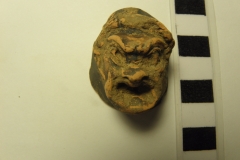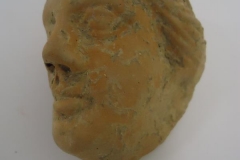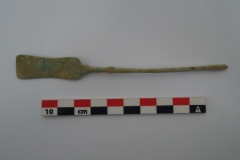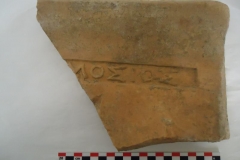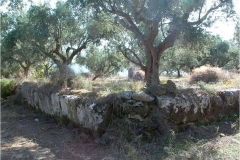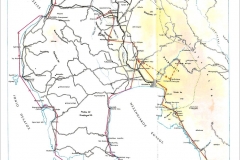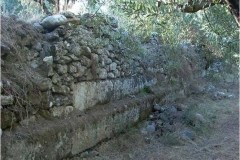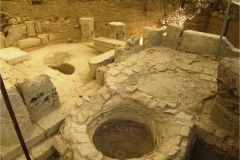During 2015 the excavation research in ancient Thouria took place in two areas: in the area of the Temple of Asclepius and in the area of “Hellenica”, to the south of the fortification wall of the ancient city.
The Temple of Asclepius
Large fillings that were removed from the southern, western and eastern side of the area allowed the identification of the temple dedicated to Asclepius and Hygeia, while the visual connection of the sanctuary was accomplished with its wider natural and historic environment, such as the fertile plain of the river Pamisos (“Makaria”) to the west, the Messenian gulf to the south and Mount Ithome to the north-west (FIG. 69). The façade of the temple was uncovered along with its three altars, while at the same time part of the foundations of the ionic stoa was uncovered, which seems to continue towards the east defining thus the area of the sanctuary from the north. The finds in the area of the stoa were very wealthy: large number of clay figurines, relief plaquettes, and feminine masks (FIG. 70, 71, 72), inscriptions, coins and bronze medical tools (FIG. 73). Parts of stamped ceramic tiles were also found with the inscription ΔΑΜΟΣΙΟΙ that confirm the public character of the buildings (FIG. 74).
“HELLENICA”
In the plateau formed on the top of the hill where the ancient city spreads, in the site called “Hellenica” an impressive peribolos II, Π shaped, was uncovered with direction N-S and with preserved dimensions: southern side: 11,65m, eastern side: 14,50m and western side: 34m (FIG. 75). The peribolos is constructed of large rectangular stone blocks carefully built according to the isodomic system. Along the western side of the peribolos a stone water channel was uncovered that rests on the external side of the ancient wall. Inside the peribolos eleven graves covered with tiles were found without offerings dated to the Christian times that belong to a later cemetery founded in the area after the abandonment of the ancient construction. The wealthy offerings of the excavation testify that the peribolos II belongs to the Hellenistic period, similarly to the eastern peribolos I that was uncovered during the excavation in 2014. Among the movable finds is a beautiful head of a clay figurine (FIG. 76) and a bead of rock crystal (FIG. 77).
FIG. 69 “Asclepeion”. The western side of the temple after the removal of the filling from the western side of the excavation
FIG. 70 “Asclepeion”. Clay figurine of Asclepius
FIG. 71 “Asclepeion”. Part of a clay female figurine
FIG. 72 “Asclepeion”. Part of a clay female bust
Fig. 73 “Asclepeion”. Bronze medical tool
FIG. 74 “Asclepeion”. Stamped ceramic tile: [ΔΑ]ΜΟΣΙΟΣ
FIG. 75 “Hellenica”. View of the peribolos II, from SE
FIG. 76 “Hellenica”. Head of a clay female figurine
FIG. 77 “Hellenica”. Rock crystal bead


